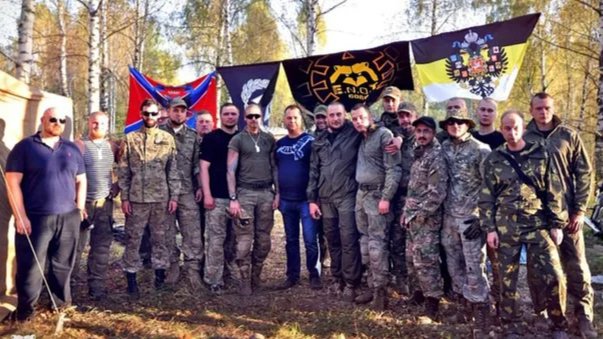“Hidden war mobilisation” is in full force in Russia: dozens of entities, including private war companies and volunteer battalions, are recruiting new members by promising a generous salary or, in case of a less desirable outcome, a “casket” payout that will go to the family. The ad campaign has reached federal levels: for example, the Wagner Group places billboards in big cities, urging people to become its new recruits, while the company’s paid advertisements put on the Vkontakte website (the biggest Russian social media ― translator’s note) have been viewed 13.5 million times.
Novaya Gazeta. Europe has counted 48 regional battalions, each with a unique name, and 11 other groups that are openly recruiting volunteer fighters and are competing among each other for the “manpower”. Our correspondents responded to the advertisements and found out who and how recruits “mercenaries”, who controls the volunteer battalions, and what training is provided for soldiers before they are sent to the frontlines.
Alexander (name changed) has spent a third of his life behind bars — charged with serious and extremely grave crimes. However this time, a few months after being set free, he became a member of the volunteer battalion Akhmat and ended up in the outskirts of the city Rubizhne, Ukraine’s Luhansk region, being fired at by Ukraine’s Armed Forces. His “assignment” fell on March and April — at that time, one of the bloodiest fights of the war was happening near Sievierodonetsk.
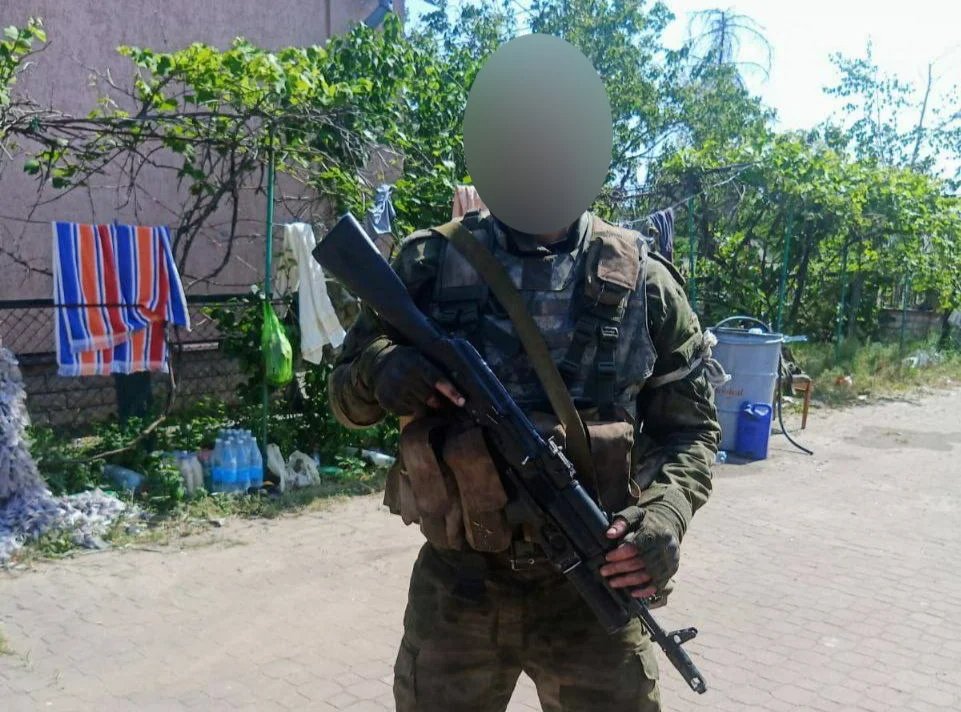
Alexander near Sievierodonetsk
“A person from the Federal Security Service told me about the recruitment for volunteer fighters. I’ve known him since childhood. At some point, we drifted apart, but after I had got out of prison, he sent me the link and was like, look, these people are recruiting volunteers,” Alexander says.
Alexander was put on administrative supervision after prison. It is a system of strict control over ex-convicts. People can be prohibited from leaving their home at night, going outside of their region, or visiting public events. Furthermore, they have to constantly appear at a police station, while policemen can legally put them under surveillance. According to Alexander, because of this supervision, he could not find work or provide for his elderly mother, which is why he decided to go to the town of Gudermes, Chechnya — according to rumours, it was there that one could solve their legal problems in exchange for participating in the war.
A base of the Russian Special Forces University is located in Gudermes; volunteers of the Akhmat regiment are trained there for the war in Ukraine. If a recruit has previously served, then the express-training takes 1-3 days. In case of no experience, recruits are trained from seven to ten days. Requirements for candidates are minimal: age from 20 to 29 and physical training that would allow a recruit to withstand daily forced marches of four miles, while wearing a load bearing vest.
“My main reason [for going to war] was to get rid of the administrative supervision, so I could eventually live in this country peacefully. I was put in an unbearable situation: I couldn’t leave my house at night, they were always trying to detain me “for twenty four hours”, and it was impossible for me to work,” Alexander explains. The Akhmat regiment management assured him that “any problem one has with the government is solvable” — apparently, the Chechen authorities can “erase” somebody’s criminal history upon agreement with law enforcement of other regions.
Our interlocutor spent ten days in Gudermes. At “university” (a private organisation connected to the Foundation named after Akhmad Kadyrov), the recruits get taught how to hold and load rifles, practice shooting positions and urgent changing of the magazine, and are introduced to tactical medicine and cartography. At the same time, the recruits are tested on their “aggressiveness”.
“They measured our aggressiveness in a practical way — inspected the person, how they behaved in a collective, and their reaction to being provoked. If somebody weren’t a fit for war, then they would just send that man home,” Alexander says. Rookies’ state of health was not of much interest to recruiters — our interlocutor was selected even with diagnosed hepatitis C; there was a recruit with epilepsy in his training unit. However, he was “verbally humiliated” and then sent home during the training stage, Alexander adds.
“Graduates” from Gudermes were people with different life stories: there were associates of the Wagner Group, OMON (Russia’s Special Purpose Mobile Unit —translator’s note) members, ex-convicts. Every third volunteer was an ex-convict, some with their criminal records “hanging over them” and some with them erased.
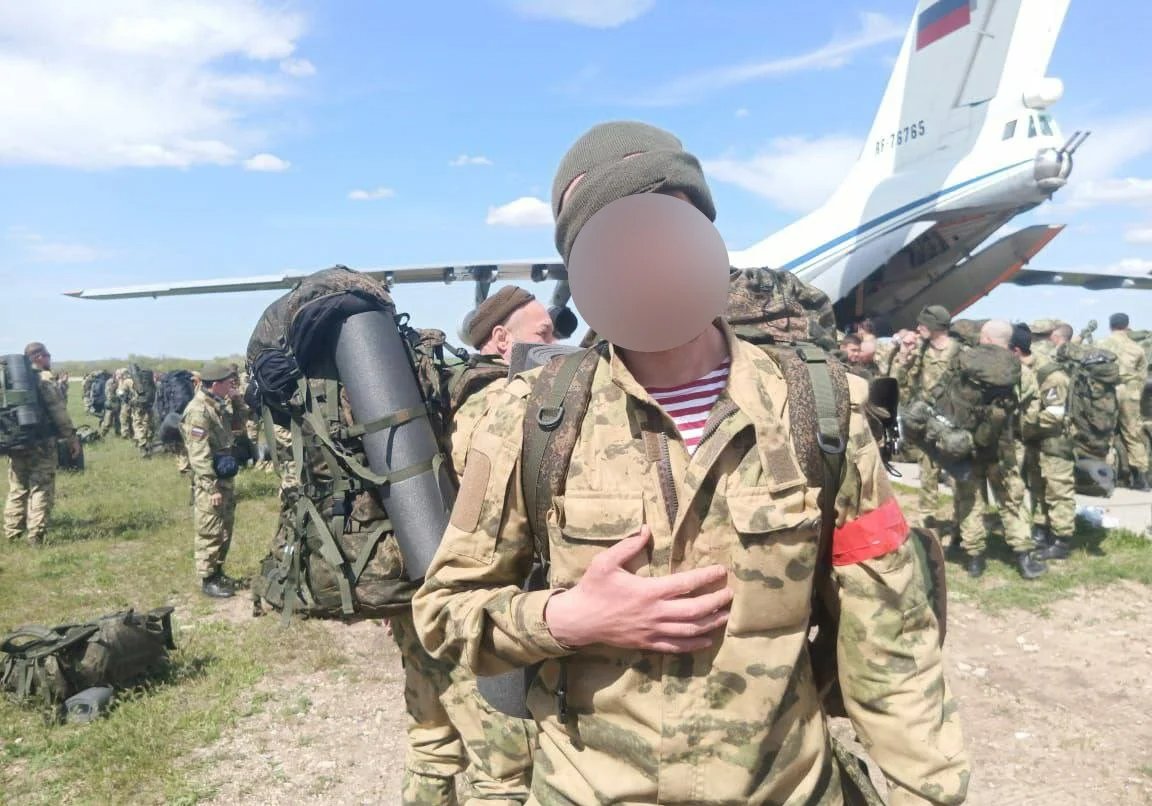
Alexander before the departure for Ukraine. His training took ten days.
“Ten days later, we were taken to Sievierodonetsk by plane, we passed through DPR. We were given 300,000 rubles (€4,783) each. They gave us camouflage uniforms. If you wanted normal combat boots and bulletproof vests, you had to buy them yourself. Some decided not to spend their money, they later took these things off the bodies of dead Ukrainians, after we had captured their positions.”
“We also had a communication problem — we were given cheap walkie-talkies from AliExpress,” Alexander shares.
This is how much starting mercenaries and volunteers have to pay for their gear*
Around 20 May, the Akhmat regiment entered Rubizhne. By that time, only a third of Alexander’s unit was still alive. “Basically everyone was eliminated, I myself only got out of the combat zone alive by miracle. It seemed as if all of us, to the last soldier, were just being thrown on the frontline as cannon fodder, every attack ended with wounded and killed,” the ex-mercenary says. “Generally, Slavic soldiers or, roughly speaking, everyone non-Chechen are treated as cannon fodder in the Akhmat regiment.”
According to Alexander, it was mostly volunteers not from Chechnya that were used for clearing the paths to Sievierodonetsk, i.e. for assault on fortified positions of the enemy. Alexander himself, due to having Chechen ancestry, was not selected for one of the most deadly assaults — the commanders let him stay back; they chose fighters for the assault based on ethnicity.
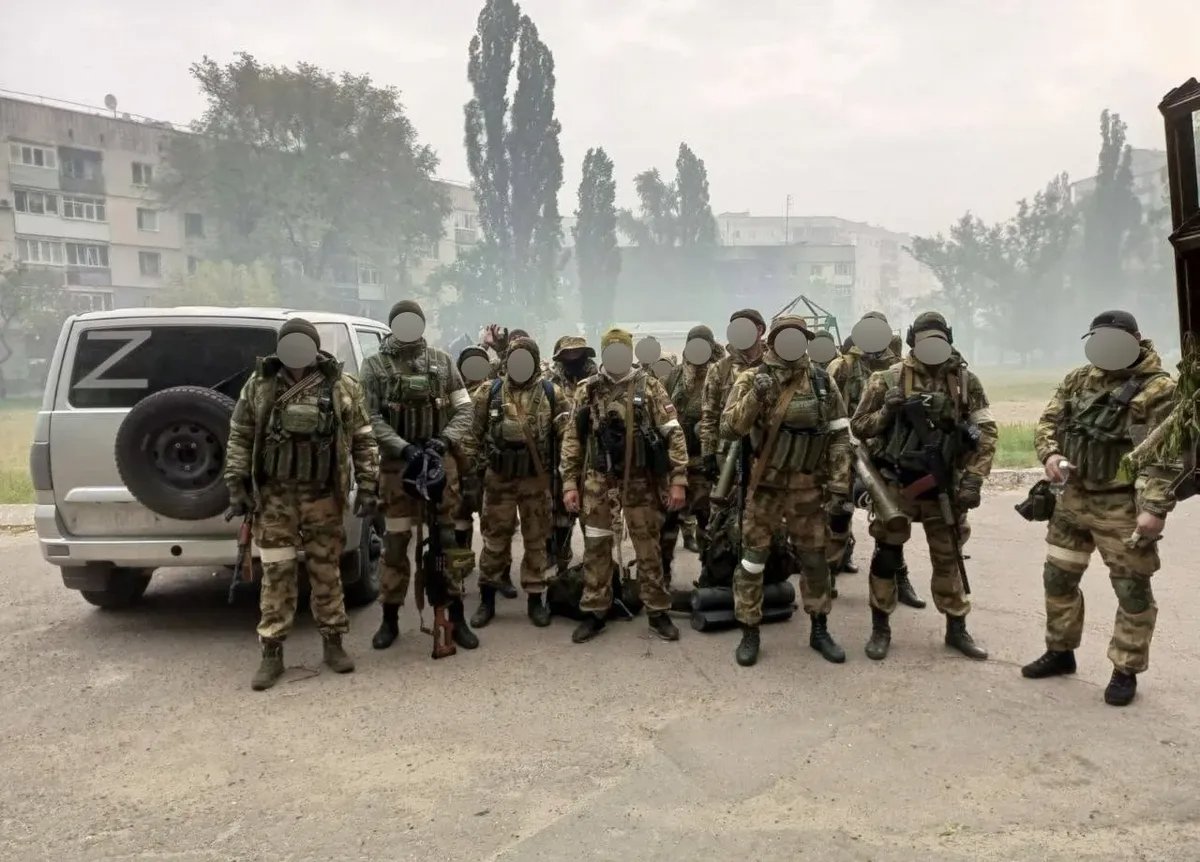
According to Alexander, most people pictured were wounded or killed during the fights for Sievierodonetsk. The photo was taken in Rubizhne
Eventually, Alexander decided to defect, grabbing a couple of grenades with him as a souvenir, and went into hiding in Russia. To tell his story, Alexander calls us at night, sometimes after a heavy round of drinking — contusions will not let him sleep, and he is afraid of going to a doctor after his unauthorised withdrawal from combat.
“I don’t know what to do, bro. They infected me with hepatitis on purpose back in the colony, I feel awful. I hope it isn’t cirrhosis,” Alexander complains; he discovered he had the infection after a surgery in a Federal Penitentiary Service facility. “Where will I find a job here in the region with the supervision hanging over me? You see, I now consider myself to be a part of a subculture, I’m a “rogue”. I was recently told that the Chechen guys were also interested in my whereabouts. I don’t give a fuck anymore, I will go harass pushers [make drugdealers share their profits with him], I do not give a fuck, I don’t want to live like this anymore. I have the [grenade] F-1 at home, I will use it to scare them. And if I get sent down — I will slit my wrists. I will ask to make a recording during the court hearing, you’ll publish it, right?”
Alexander was not able to solve his problems with the law through the Akhmat regiment because he had defected. He also, obviously, did not receive the second payout — another 300,000 rubles (€4,783). Still, the ex-mercenary did not actually sign any contract with the Chechens.
Another volunteer, who also went to war through Chechnya, told Novaya Gazeta. Europe that he had signed a contract with Russia’s Defence Ministry. He was wounded in the spine and spent several months after leaving Ukraine trying to get compensation for medical treatment from the Russian authorities. By the time of the publication of this story, the government had paid the volunteer the entire promised sum.
Parade of mercenaries
It was the Akhmat regiment, as part of which Alexander went to war, that Dmitry Kiselyov advertised during prime time on state TV. The Akhmat regiment has become infamous since the start of the war. Kadyrovites have become known as “TikTok troops” for their countless staged PR-videos. According to Ukraine’s data, ethnic Chechens usually were, in fact, not the first frontline fighters during assaults. Despite that, it is the Akhmat regiment that is considered to have been involved in the brutal torture of Ukraine’s POWs and the massacre of civilians in Bucha.
Video of State TV programme Vesti Nedeli (hosted by Kiselyov) advertising recruitment in the Akhmat regiment. Source: Telegram channel Agentstsvo
The meeting point for recruits in Chechnya is the city hall of Grozny, Chechnya’s capital. They are being offered a three-month contract with the Defence Ministry — the pay is 150,000 rubles (€2,360) per month, with additional payments for destruction of military equipment and killing Ukrainian soldiers.
- 300,000 rubles (€4,783) for a downed aircraft;
- 200,000 rubles (€3,147) for a downed helicopter;
- 100,000 rubles (€1,574) for a damaged tank;
- 100,000 rubles (€1,574) for killing military personnel up to an entire squad (up to 60 people);
- 50,000 rubles (€787) for destroying drones, armoured vehicles, anti-aircraft missile systems, artillery units, multiple launch rocket systems, and killing military personnel up to a unit (up to ten people).
Following Chechnya’s example, other regions also started creating special battalions, with from 150 to 400 members each. There is the Vyatka battalion in the Kirov region, Parma and Molot in the Perm region, three battalions at once in Mari El: Iden, Poltish, and Akpatir. All in all, we counted 52 battalions that have already gone to the frontlines or are just being formed in 33 regions. Based on the known number of regional battalions, from 9,500 to 20,000 volunteers could be recruited to serve in them.
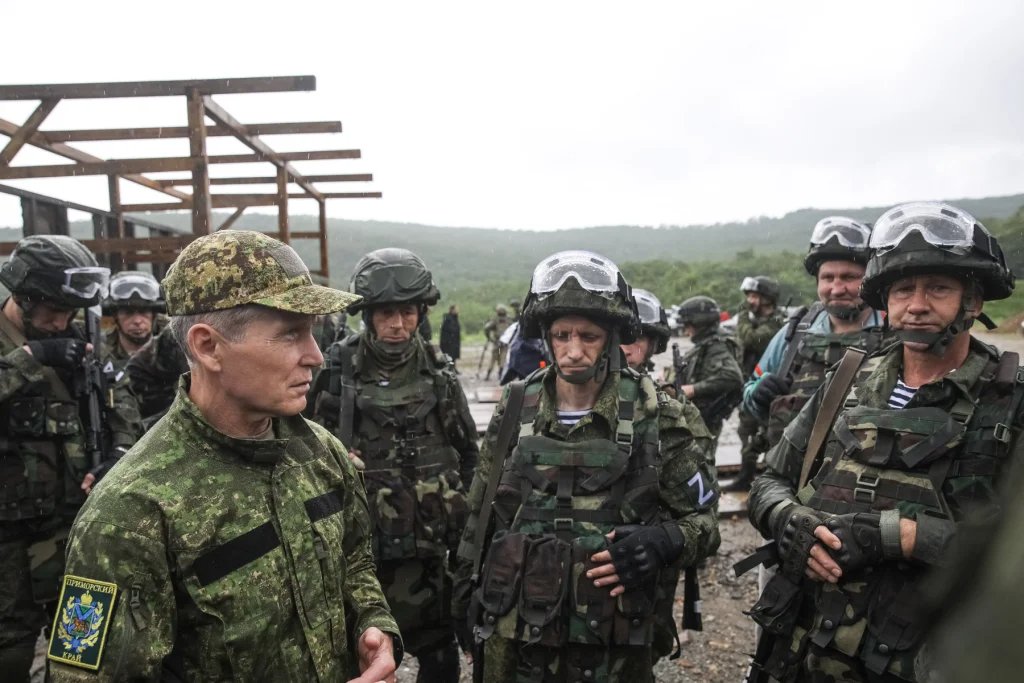
Volunteer fighting unit Tigr. Source: the Primorsky region government
Men aged from 18 to 60 can become volunteers. For example, the majority of the fighters in the Tigr unit of the Primorsky region is over 50, according to the governor Oleg Kozhemyako. There are plans to sign standard contracts with all the new recruits through the Defence Ministry. Additionally, the regions are promising to equip the fighters of such battalions with military gear, help with accommodations, and provide them with additional payments. The training usually lasts for one month on several polygons: the Totsky polygon near Orenburg, in the town of Luga in the Saint Petersburg region, near the city of Nizhny Novgorod, and in other cities.
Training sites
Source: Novaya Gazeta Europe’s data
“Such things, in Russia, usually happen in a hybrid way. Someone from the region, in this case Chechnya and Ramzan Kadyrov, propose a model. Afterwards, governors of other regions, trying to curry favour with the Kremlin, follow the set example. This is exactly what happened this time,” political scientist Ivan Preobrazhensky says.
The Kremlin thinks that these are battalions made up of marginals and convicts that will be quickly “utilised” as cannon fodder sent to the frontlines or left in the occupied territories in the capacity of “policemen”, Preobrazhensky adds. But in reality, according to him, this situation poses risks of separatism after the war.
At the same time with the government, other entities, which are also explicitly or implicitly connected to the Defence Ministry, are recruiting mercenaries. We counted more than ten groups that are competing among each other for manpower. We divided all of these entities into several groups on a formal basis — are they directly controlled by the Ministry of Defence, do they act through a private military company or even through the self-proclaimed Luhansk and Donetsk “people’s republics” (“LDPR”).
Who is recruiting volunteers and mercenaries for the war in Ukraine
The strictest requirements for recruits come from PMCs Redut and Wagner (although, due to the lack of candidates, PMC Wagner has started to reduce their requirements: the maximum age has increased from 45 to 52, the candidates are no longer turned away if they had not served the compulsory military service, and having a criminal record is no longer an issue). Both PMCs are implicitly associated with the government. The Wagner Group is financed by Vladimir Putin’s close associate, businessman Yevgeny Progozhin; PMC Redut is said to be connected with the Defence Ministry.
Less prepared fighters go to the Donbass volunteer union of the State Duma deputy Alexander Borodai or the Russian legion of the banned National Bolshevik Party ex-member Sergey Fomchenkov. Volunteers of these groups are officially registered as reservists of the Military reserve force of Russia, subordinate to the Defence Ministry. At first, it was expected that the reservists would guard checkpoints and convoys, i.e. not actively participate in combat. However, these battalions are often sent to the frontlines.
Finally, basically any “job seeker” is accepted into divisions of “LDPR”’s people’s militias. Although, they are not guaranteed neither payouts nor any equipment. They are promised DPR and Russia’s citizenships in exchange for their service.
The mass recruitment of mercenaries and volunteers is a part of the so-called “hidden mobilisation”. The government cannot announce an official, compulsory mobilisation due to political reasons: that would lead to a mass draft evasion, a corruption increase among the military enlistment office employees, and, respectively, a big citizen discontent, military expert Yuriy Fedorov explains.
He thinks that, all in all, up to 10,000 mercenaries could be active in Ukraine. It is around 10% of the Russian military personnel. Military expert Pavel Luzin estimates the number of mercenaries and volunteer fighters in various “irregular” units to be about 15,000-20,000 people.
According to the expert, by recruiting mercenaries, the government pursues three goals:
- recruitment of “cannon fodder”;
- utilisation of “superfluous people” that, in theory, could oppose the authorities, with weapons in their hands (for example, as did Primorsky Partisans, which attacked Ministry of Internal Affairs agents in 2010);
- counterbalance to the army.
“The Kremlin is afraid of the army, afraid that there will be a new Zhukov, a new Lebed, Rokhlin, a new Troshev, in the worst case scenario (i.e. popular, famous generals that could wield independent political power —editor’s note). Fragmentation of military power is a characteristic of all authoritarian regimes,” Luzin adds.
Volunteers over 40
“Do you even realise where you are going? And what could happen there, do you understand that? Did you evaluate all the risks?”
We are calling the Donbass volunteer union. According to the legend, our volunteer is 23, he has served before, and wants to go to the frontline. But recruiter Anastasia unexpectedly begins to discourage him.
“We, of course, technically, take 23-year-olds, but we wouldn’t want to see children in the battalion,” Anastasia says. “Let’s think about your mom…”
“Always thinking about my mom”.
“How many kids do you have?” the recruiter keeps pressing.
“I don’t have any children.”
“Russia needs children! We are in a demographic crisis! Maybe, you will make some children instead, no?”
Finally, the recruiter gives up. The meeting point is hotel TImosha in Rostov-on-Don. The recruits are sent to Ukraine, “destination Izium”, basically immediately — one-two days after arrival. The gear is minimal: uniform, bulletproof vest, helmet. If you are lucky, you get a load bearing vest. Everything else, you have to buy with your own money. Training and combat coordination classes took place, but we were too late to attend. “They will still be happening for maybe three days,” the recruiter says.
By the way, the length of recruit training during the Ukraine War does not resemble that of an operation prepared in advance and is comparable only to the Great Patriotic War or the First Chechen War.
Minimum training time during past and present conflicts
Time necessary for recruit training / weeks
The Donbass volunteer union signs official Defence Ministry contracts with volunteers. The minimal term of a contract is two months. The union promises to pay soldiers 205,000 rubles (€3,278) per month and provide them with government payouts in case of injury or death. If the government “ditches” them, the union says it will help to “get back” the promised payouts.
Military expert Pavel Luzin thinks that the union is affiliated with the Federal Security Service (FSB). But in practice, the volunteers become part of the Military reserve force battalions. The Defence Ministry started to recruit reservists a year ago — back in autumn 2021.
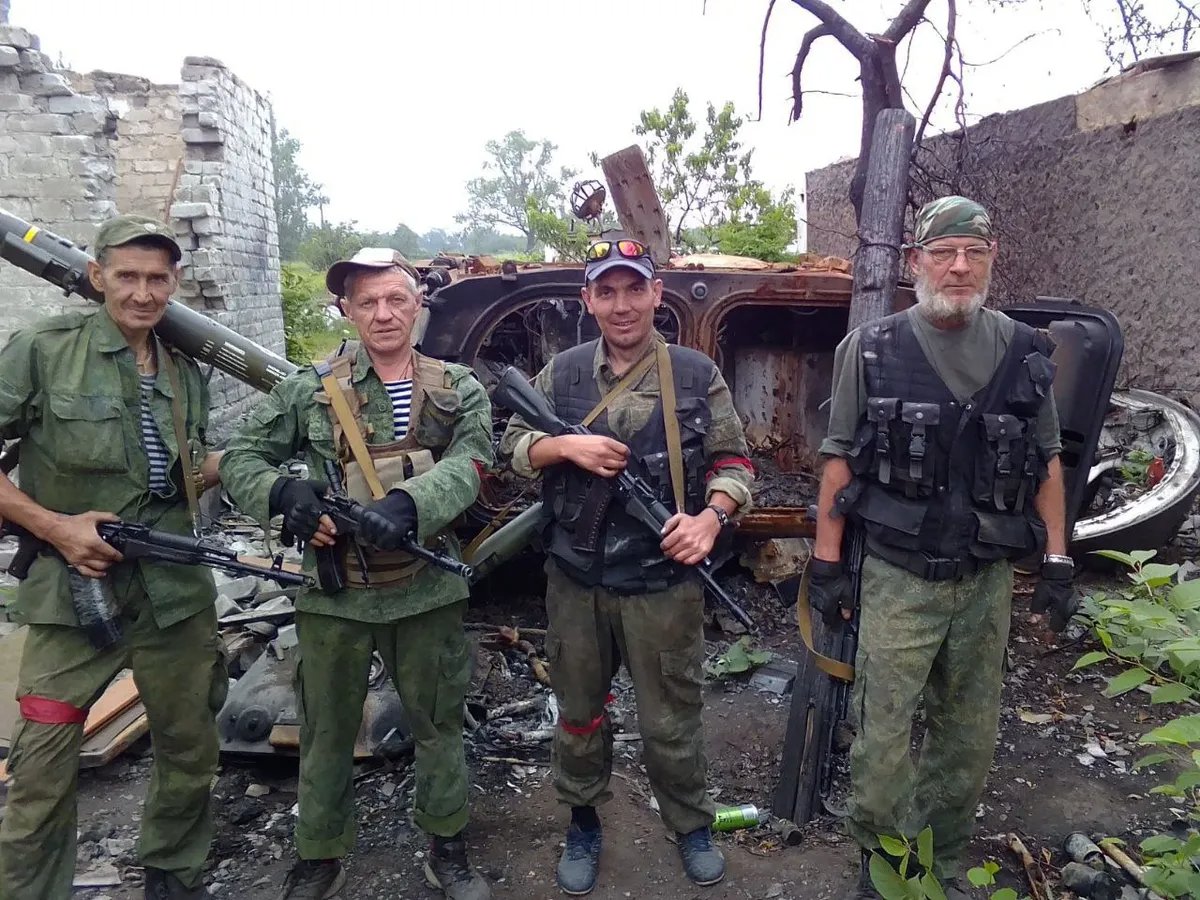
The Donbass volunteer union volunteers. Source: Telegram channel of the Donbass volunteer union
All in all, the Donbass volunteer union has already formed three Military reserve force battalions: Oryol (Military reserve force battalion#9), Rurik (#13), and Grom (#20).
“In general, [volunteers] are people [of the age] 40+,” the Grom battalion commanderб Alexey Nalivayko, call-sign Ratibor, says. “People that have seen the USSR themselves. There are very few young people.”
“Every second or third man has back problems, legs that hurt,” nationalist Anton Rayevsky previously said in a video. He was the commander of the third platoon, second company in the Military reserve force battalion#8.
Another Military reserve force battalion Russian legion is recruited by Sergey Fomchenkov, call-sign Fomich. He used to be a member of the banned National Bolshevik Party and leader of the Zakhar Prilepin Guard.
Military reserve force volunteers face basically no requirements. In their battalions, there are even “grandads”, men over the age of 60, Ratibor said in the past. They do not have access to armoured vehicles or artillery, except for mortar batteries. They do not go into combat autonomously, like they did in 2014. Usually, Military reserve force battalions are joint with an army unit, and they are commanded by professionals.
Recruiters, and even mercenaries themselves, openly call Military reserve force volunteers “cannon fodder”. Possibly, this is why recruiter Anastasia tried to dissuade us so insistently.
It is even easier to be recruited into the battalions of the self-proclaimed republics — Sparta and Pyatnashka. People with IDs from Ukraine, “LDPR”, and CIS countries, people with any document issues, they all get accepted. Although, there are also no [payments or benefits] guarantees.
Volunteers have to reach Donetsk on their own. All the gear is bought with their own money. “Unfortunately, we do not have the means to equip everyone with gear, we have queues for bulletproof vests and helmets,” admits a representative of The Other Russia of E. V. Limonov, a non-registered Russian political party; they are responsible for recruiting mercenaries for the Pyatnashka battalion. The commander is Akhra Avidzba, call-sign Abkhaz.
“The volunteers are registered through DPR. The payouts are done by Donetsk’s government. It is possible that, soon, there will be problems with money and sticking to commitments, I’m not going to lie. It’s better to solve all financial questions by yourself. There are no guarantees in case of an injury or death.”
Volunteers are trained for ten days only, directly in Donetsk — “well, you understand, this is wartime.” The volunteers are promised citizenship of “DPR” and Russia in exchange for their service. Although, there is a big risk to not make it to the receival of citizenship. According to experts, badly equipped “LDPR” forces are the ones suffering the biggest losses.
Job Fair
First advertisements seeking mercenaries appeared a week after the star of war. On 2 March, a post was published by PMC Wagner, financed by Prigozhin, on their Vkontakte (Russia’s biggest social media — translator’s note) page. A month later, similar advertisements started showing up on Telegram. In particular, the Russian legion and the Wagner Group began seeking mercenaries and volunteers to go to Ukraine on Telegram at the end of March. One of the last groups to pay for ads, in July, was PMC Redut, which our interlocutors connect with the Defence Ministry.
It is Vkontakte — a social media controlled by the government — that saw most of PMCs’ ad activity. We counted at least 568 advertisements seeking volunteers published since the beginning of the war up to 14 July. All in all, they were viewed 13.7 million times. Out of that number, advertisements by the Wagner Group were viewed 13.5 million times. Such a high number was reached, in part, due to paid advertisements.
For comparison, we found almost 490 advertisements seeking mercenaries on Telegram, by using the TGStat service. Their total coverage amounted to 3.8 million views, i.e. three times less. At first, these ads were published in countless “Z” groups and security guard chats, but starting from summer, the posts became more frequent in normal ad groups and job searching chats.
We decided to call all the groups that are recruiting volunteers on social media and find out the contract terms. The basic legend is: a young 27-year-old man, his military occupational speciality is shooting, his service experience is two years under contract. Sometimes, we would say that he had an outstanding conviction to see if there were ways to make it go away in exchange for mercenarism in Ukraine.
Usually, that information was enough to ask questions and get an invite to a meeting point. These points could be located in a hotel, a training polygon, a city hall, or even a private residence, in case of the Veterany battalion. Once there, the potential mercenaries’ data is verified against an Internal Affairs Ministry database, we were warned by recruiters.
Mercenary meeting points
Meeting points for mercenaries and volunteers, from which they go to Ukraine
Still, some recruiters proposed that, first, we fill out a questionnaire. For example, this is one from the Russian legion. It is simply uploaded to Yandex.Forms. Candidates should fill out their full name, contact information, military experience, and military specialisation.
The requirements differ from unit to unit: there are differences in required age, citizenship, military experience, and tolerance of past or present convictions. Furthermore, headhunters often compete for the same mercenaries and “steal” them from one another.
- A mercenary should be at least 18 years old.
- Maximum age for a candidate is 60 years.
- Army experience and a military specialisation are not required.
- Convictions, even outstanding ones, are allowed.
- Citizens of “unfriendly” countries will not be recruited, however, Ukrainians and descendants from post-Soviet countries can become recruits.
- Certificates on absence of infectious diseases — hepatitis B and C, HIV, tuberculosis — are required.
Often, recruiters remind that mercenaries sign short-term contracts with the Defence Ministry. However, we did not manage to establish if that is true or not. Besides, these contracts are not mentioned by every military group.
‘He just needs cannon fodder’
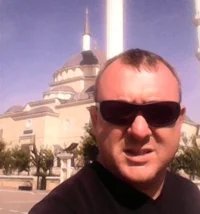
Timofey “Kesha” Bormin. Source: his Vkontakte account
“If you took part in any combat, then maybe you have something of your own: a backpack, a vest, a uniform that you like. In general, we give our recruits clothes and shoes, equipment,” recruiter of PMC Redut, TImofey Bormin, call-sign Kesha, tells us over the phone what we should take with us to war.
PMC Redut is one of the biggest unofficial players in this war. It is Redut’s numerous units, out of all PMCs, that went to the frontlines at the beginning of the war and invaded Ukraine on 24 February both from “LDPR” and Belarus, reported Russian independent outlet Meduza.
Kesha keeps trying to make us go to Tambov. Redut trains rookies on the polygon Trigulyai, on the base of the 16th Separate Guards Special Purpose Brigade of GRU. This brigade already partook in the war in Ukraine in 2015. These people are the ones training mercenaries. The training lasts for “at least two weeks, you will go to the polygon two-tree times”, the recruiter says.
After the training, the recruits are sent to the town of Valuyki in the Belgorod region, located a dozen miles away from Ukraine.
PMC Redut is affiliated with high-ranking Defence Ministry generals. This fact was reported by Novaya Gazeta (back then, the PMC was called Shield), Meduza, and Ura.ru. “The contract you sign is with the PMC. But we work under the Defence Ministry,” the recruiter explained.
- Men with experience in law enforcement.
- Age from 24 to 45.
- The recruit should not be currently prosecuted by law enforcement agencies. But in general, having a criminal record (unless the recruit was charged with pedophilia, drug trafficking, or rape) is not a problem.
- Certificates on absence of hepatitis, HIV, and tuberculosis are required.
It is very profitable for the government to recruit such mercenaries. They do not appear in official losses statistics (even the official one has not been mentioned since March), most of the mercenaries do not get neither the “casket” payouts, no free rehabilitation, nor housing, nor military benefits.
How much do mercenaries and volunteers get paid
Amount of the minimal monetary allowance / thousand rubles
PMC Redut members get paid once a month — dollars in cash. If needed, one can easily exchange it or transfer it to their card. “Compensations are provided. From $5,000 to $2,000 in case of an injury. In case of death, your family receives $60,000,” Kesha says.
For comparison, official compensations in case of an injury or death are several times higher. Servicemen and Russia’s National Guard employees receive up to 6 million rubles (€93,642) for an injury, their relatives — 12.5 million rubles (€195,088) in case of death.
Part of the gear (clothes, sleeping bag, backpack, dishes) is given out by PMC Redut. But everything else — load bearing vests, bulletproof vests, etc. — mercenaries have to buy themselves. As a rule, the additional gear costs around $700.
“From government's point of view, a mercenary can be just given a rifle and an old armoured vehicle. He goes and gets himself blown up somewhere — well, okay then,” military expert Pavel Luzin explains. “In the army, the same number of infantry men need to be provided with a tank battalion for support or a tank company, an artillery division, a signal company, a logistics company, they also need air support, headquarters, medical service. They have to dress these soldiers, give them boots, feed them, provide them with radios and drones. More soldiers, more veterans. Instead, here, you recruit a thousand mercenaries, throw them into the war. They die, okay.”
Currently, PMC Redut is recruiting at least five units. One of them is a “reconnaissance and sabotage unit Tigry” under the command of someone known as Biker, according to Kesha. “[Biker] is very famous in GRU — a staff officer, lieutenant colonel,” he says, declining to give a straight answer on who the commander is.
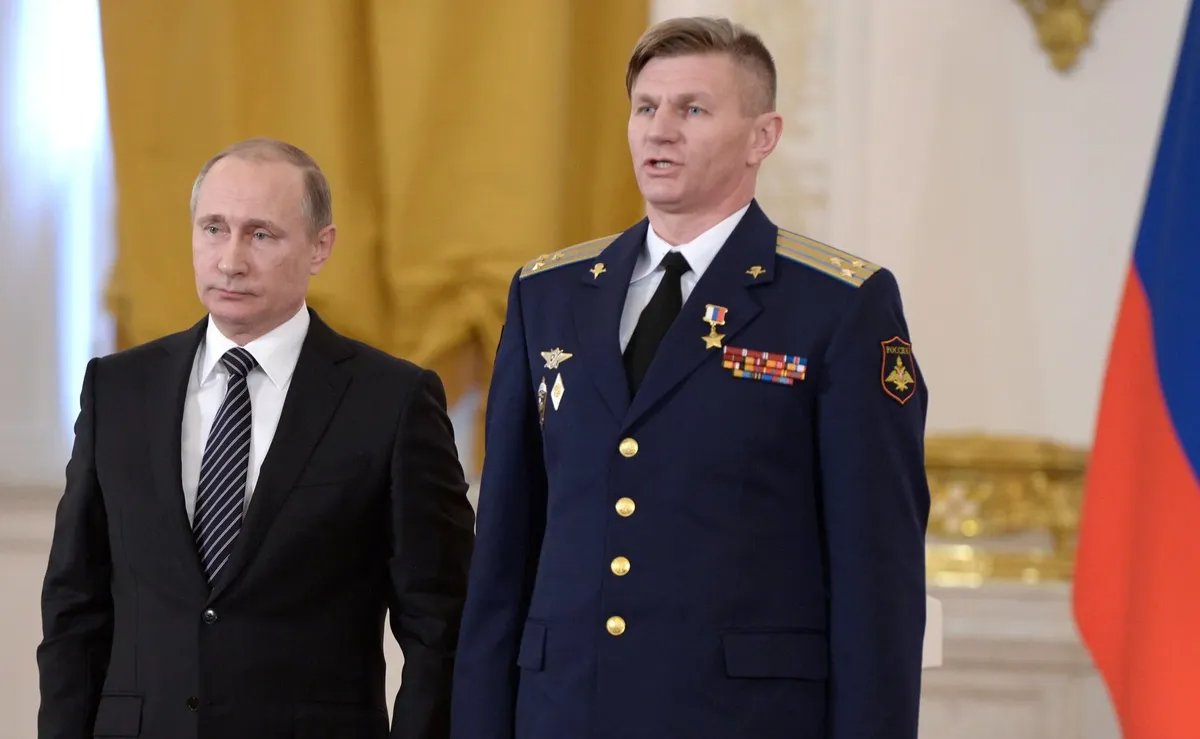
Vadim Baykulov during a ceremony where he was awarded the title of Hero of the Russian Federation, 2016. Source: Wiki-org.ru
The only person fitting these criteria is Vadim Baykulov. Until 2010, he served in the aforementioned 16th Separate Guards Special Purpose Brigade of GRU, in 2015-2016 — participated in the Syrian War as a member of the special purpose centre Senezh.
Aside from that, volunteers and mercenaries for units Volki and Sever, the Veterany battalion, and the Don brigade all get recruited through PMC Redut.
“We invite you to become a volunteer of our unit. We work under a contract from the Defence Ministry,” Cossack Alexander, call-sign Palich, says in an agitation video.
Palich usually publishes his agitation posts on Odnoklassniki (a Russian social media website, popular mostly among older people — translator’s note). He is over the age of 50 — he served during the Soviet times, in the Baltics. However, despite his age, his social media profile is full of naked women and tuned cars. There are also posts with stylised swastika, resembling the sign of Russian National Unity (an unregistered neo-Nazi movement — translator’s note) and the symbol Square of Svarog. According to his profile, he is in favour of Volgograd getting its old name back (Volgograd was previously called Stalingrad — translator’s note). About himself, he writes: his interests are “healing, analytics, and anti-crisis management.”
On the list of Palich’ friends is Cossack Vasiliy Grechishkin, call-sign Aryan. He has already fought “Nazis” in Ukraine as a member of units Pyatnashka and Don. He got wounded and , later, awarded a medal to Participant of combat and local conflicts (such medals are sold on Russian online marketplaces for 1,000 rubles (€16)).
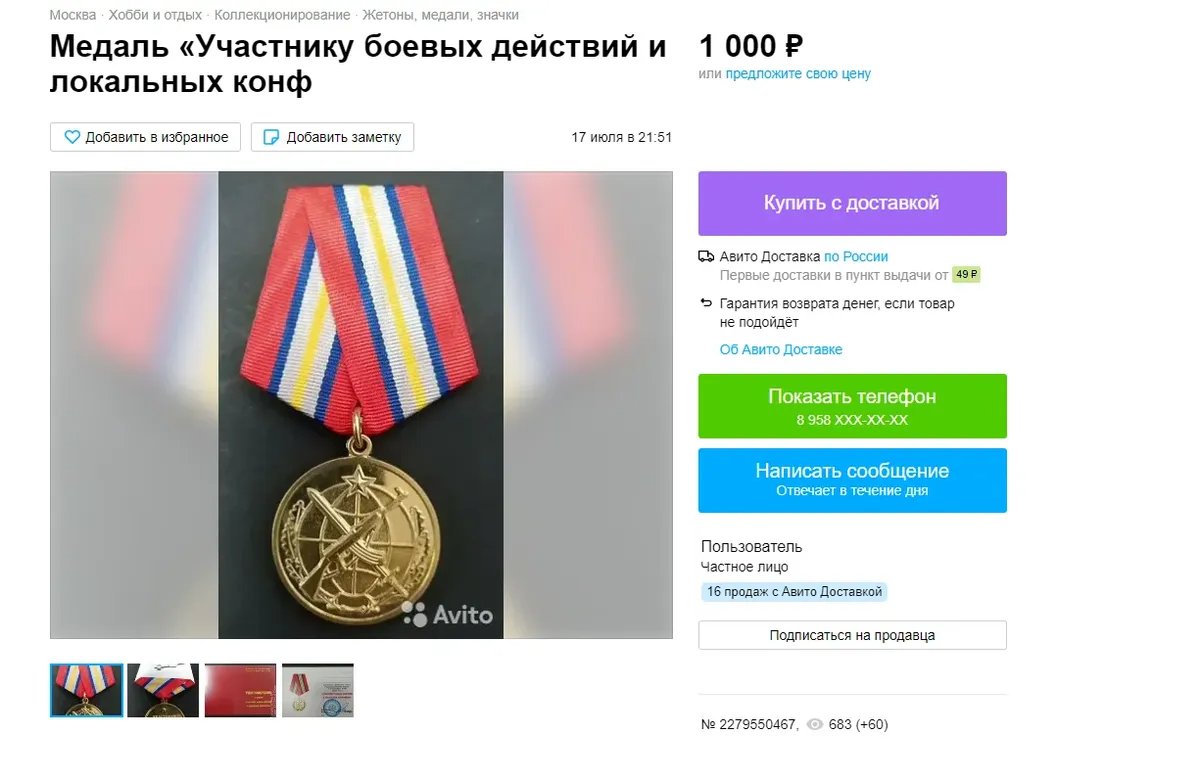
A user selling a medal that was awarded to participants of the Ukraine War on a Russian marketplace Avito. Source: Avito
The Cossack assault unit Don was in Ukraine at the end of April under the command of a certain man nicknamed Morpekh. The unit members fought near the city of Izium in the Kharkiv region as part of the 60th Separate Guards Motor Rifle Brigade. According to what one of the recruits told us, the unit suffered significant losses, and now Morpekh is forming a new unit Veterany, no longer a Cossack one. Furthermore, vice commander of the Veterany headquarters, Alexander Kishinets, simultaneously works in the headquarters of Zakhar Prilepin in Izium. One of the Veterany recruiters is a certain man nicknamed Major. In the application GetContact, his number is written up as “FSB Moscow”.
“He [Morpekh] is currently in Valuyki forming a new unit. And he steals our people — recruits that are going to us (to Biker), to units Volki and Sever. And he just straight up intercepts the guys that were on the way to us, loads them up, and drives them away. He just needs cannon fodder,” recruiter Kesha laments over the phone.
Simultaneously, in the middle of June, the Union of Cossacks-soldiers of Russia and Abroad started forming a Cossack brigade Don. One battalion, Terek, has already been formed, there are two still to form — Kuban and Yenisei.
Only married Cossacks with children are accepted in the brigade. “So that their family line continues, in case the father does not come back from the special operation,” Supreme Ataman of the union, Nikolay Dyakonov, previously explained.
However, this requirement, it seems, applies only to Cossacks. “You only have to take your ID — nothing else is needed,” Alexander, call-sign Palich, says over the phone. He promises free gear. Monetary allowance — “at the place of deployment, $1,800 [per month] and additional payments from the commander. On the frontlines — around $4,000,” Palich explains.
The payments come from the state budget — through the Defence Ministry, and specifically — through PMC Redut. Thus, the Cossack units go to war independently from PMC Redut but use it for recruitment of volunteers and receival of payments. “Redut is a financial organisation, through which all payments are made,” Palich adds.
Rusichi and where to find them
Paradoxically, one can end up at the frontlines fighting “Nazis” even as a member of a ultra-right group. The Russian Imperial legion and unit Rusich are recruiting volunteers. Both of the self-called volunteer units actively participated in the Donbas armed clashes in 2014-2015. The Russian Imperial legion participated in the fighting near the cities of Sloviansk, Donetsk, Debaltseve, river Mius, and village Nikishine. The Rusich unit became famous after a battle with Ukraine’s battalion Aydar near the village Tsvitni Piski in the Luhansk region in 2014.

Rusich commander Alexey Milchakov. Source: Meridian
“I am a Nazist. I can even do the hand gesture,” Alexey Milchakov said in the past in an interview with nationalist Egor Prosvirnin.
Milchakov, commander of the Rusich unit, became famous in 2011 when he had published a video on his Vkontakte page where he brutally killed a puppy and then ate it. In general, he never hid his views.
“When you kill a person, you feel: a) hunting excitement (if you have never hunted — do try) and b) you feel that there’s now one less problem,” he flaunted in the same interview.
Milchakov’s vice commander is also a neo-Nazist and neo-pagan: Yan Petrovsky, call-sign Slavyan. The Rusich unit was on the frontlines on the first day of war — 24 February.
The Imperial legion is effectively commanded by Denis Gariyev. The movement’s slogan is: “God. Tsar. Nation.”
“We are sceptical towards declarations about denazification and demilitarisation of Ukraine. For us, this is a religious war. If we lose this war, the Russian Orthodox Church of Malorossiya will be effectively destroyed. It’s already happening. The churches are being given away to Uniates. It has already been announced that, in case Ukraine wins, the Russian Orthodox Church will be eliminated,” Denis Gariyev explains in a video for his supporters. When we asked legion’s recruiters about payments, they answered that “their mission has nothing to do with money”, and stopped talking to us.
In 2020, the United States Department of State included the Russian Imperial movement in the list of international terrorist organisations. The Rusich unit is featured in Canada’s sanctions lists.
Both the Imperial legion and the Rusich unit took part in the Donbas War straight from the beginning — from 2014. And both of them came back to Ukraine at the beginning of the Russian invasion. Both groups have a nationality filter — they only accept Russians. The legion also prioritises Orthodox Christians and combat veterans.
According to Gariyev, compared to 2014, his unit is now fighting in Ukraine “officially” and is a part of the Military reserve force, subordinate to Russia’s Defence Ministry. “In practice, volunteers are no longer volunteers, everyone is a part of structure, everyone signs a contract, everywhere, there are matching guarantees and benefit payments, even though they are not the same, depending on the particular organisation. There are orgs that are subordinate to the Defence Ministry but are not a part of it,” Gariyev says.
Both units are based in Saint Petersburg and are registered as legal entities. There, they also recruit and train volunteers before they are sent to Ukraine. The headquarters with training facilities of the Russian Imperial legion is located in the basement of a five-storey residential building and exists as a tactical and firearms training centre Partisan. The space is owned by an acquaintance of Gariyev. In the same location, there is a military gear store.
Partisan conducts paid courses on fire training, city fighting, medicine, artillery reconnaissance, drone piloting, and more. According to Der Spiegel, citing German reconnaissance, Gariyev used to receive big government orders from Russian law enforcement agencies. Company Eureka, of which he was a co-founder, did have contracts with FSB, Federal Protective Service, Internal Affairs Ministry, and Prosecutor’s Office; however, it provided these agencies with cardboard folders and paper targets for shooting classes.
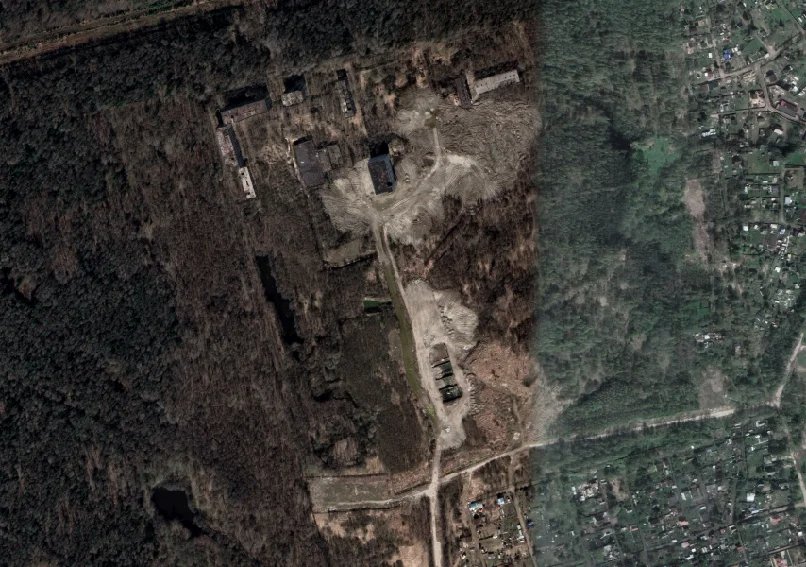
Polygon Ogino, 60°01'37.1"N 30°05'36.3"E. Source: Google Earth Image © 2022 Maxar Technologies
According to Novaya Gazeta. Europe’s findings, the legion's training in field conditions takes place in the Primorsky district of Saint Petersburg, on the territory of an abandoned military base, near the North-West Thermal Power Plant. Until 2014, this territory belonged to a federal fund, then to businessman Mohamed Elhadi. Polygon’s latest owner is a businessman from Chuvashia, Vladimir Andreev, who was recently declared bankrupt.
Training of the neo-Nazi unit Rusich takes place in the outskirts of Saint Petersburg and, in particular, on the territory of a shooting range in the Kolpinsky district. There, fire training classes featuring military weapons are conducted. Aside from their own fighters, instructors of the Rusich unit and of organisation Svorog, which specialises in tactical medicine, train people recruited by the Donbass volunteer union.
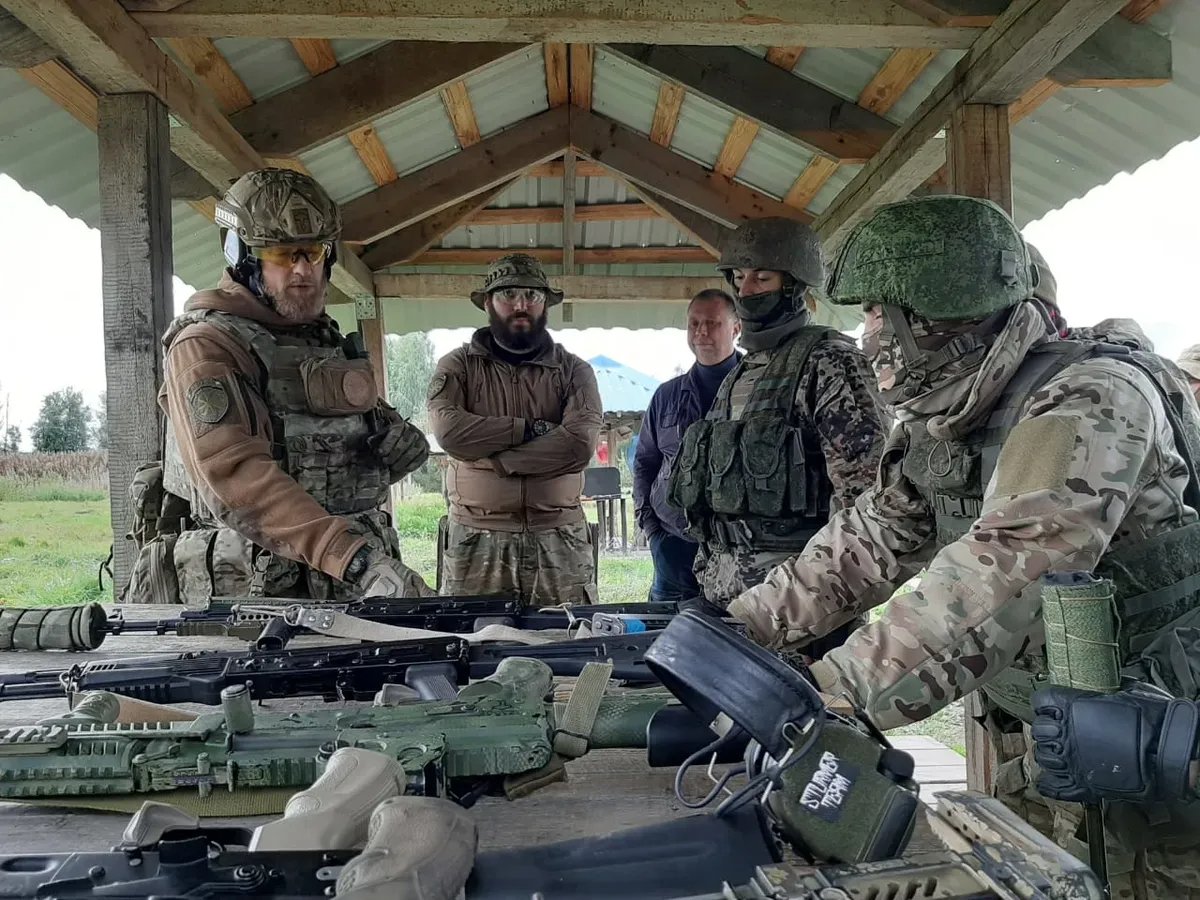
A joint training session of the Donbass volunteer union and the Rusich unit in Saint Petersburg, 2020. The man on the left is Yan Petrovsky, call-sign Slavyan; the man in the centre is Alexander Borodai. Source: Social media of the Donbass volunteer union
“I have known of the Rusich unit for a long time. I can say that I’m very appreciative of these guys, they are real Russian patriots,” leader of the Donbass volunteer union, Alexander Borodai, said at one of the joint training sessions.
Furthermore, one of the union’s videos states that Yan Petrovsky is part of the union’s unit Centre. Slavyan is introduced as head of the Saint Petersburg branch of the Donbass volunteer union.
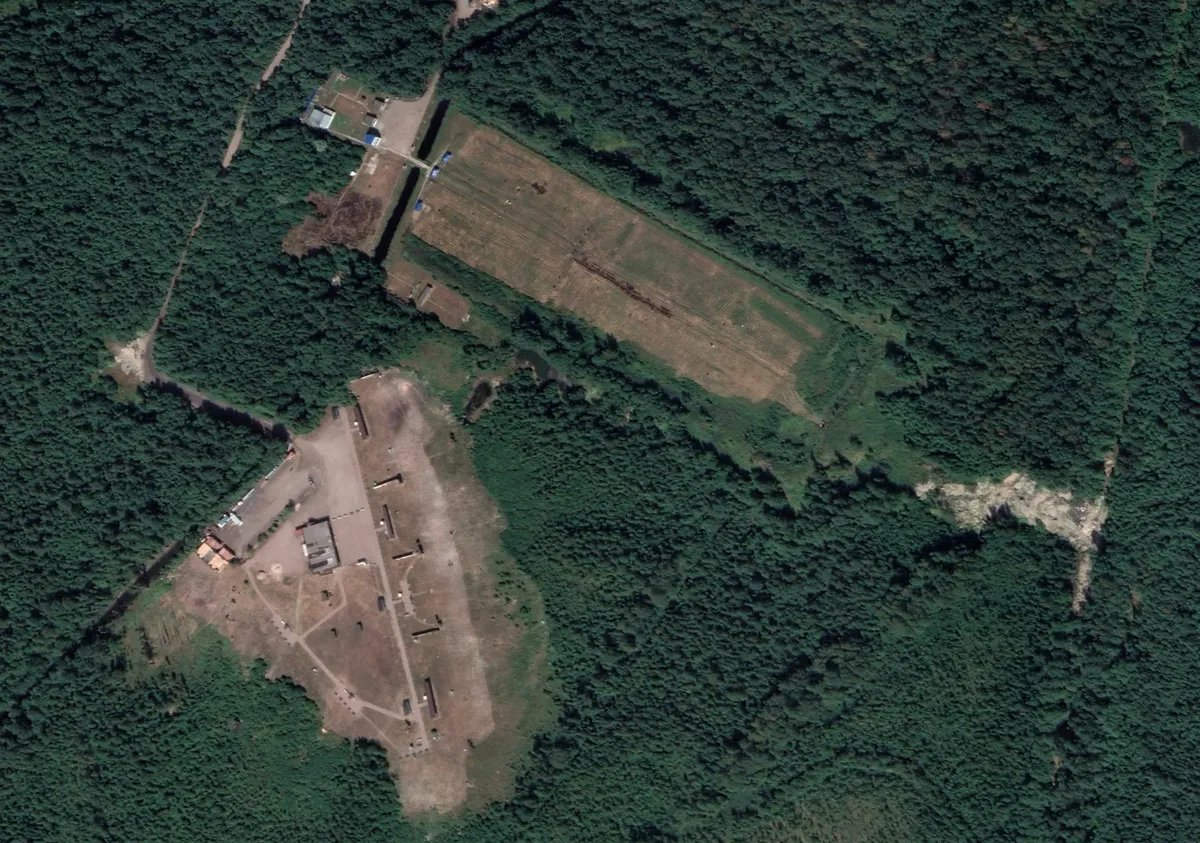
59°46'04.9"N 30°39'23.6"E. Source: Google Earth Image © 2022 Maxar Technologies
Finally, another person busy recruiting volunteers for the Ukraine War is ex-leader of the right radical organisation Russian National Unity, Alexander Barkashov. This organisation also participated in the fighting in the South-East of Ukraine in 2014.
On social media, Barkashov is recruiting people himself for a certain PMC that offers a contract that pays 250,000 rubles (€3,996) per month, benefits, and compensation to the relatives in case of death that amounts to 8 million rubles (€127,856). Before going to war, a volunteer has to pass a one-month training and combat coordination course on one of Russia’s polygons, to where he needs to travel by his own means.
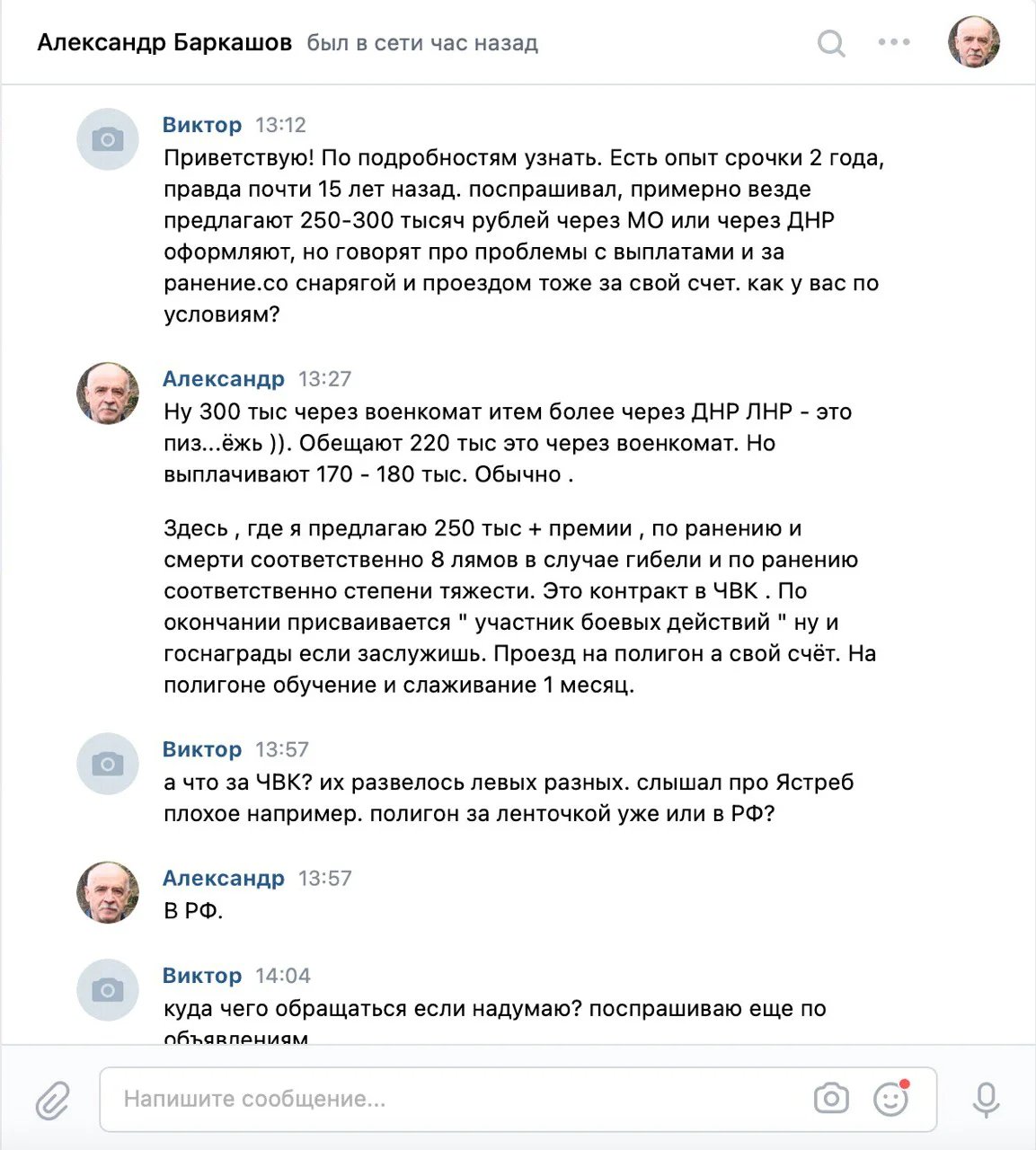
Our messages with Alexander Barkashov on Vkontakte
Your homeland will abandon you, son
Judging by conditions, in which recruitment of volunteers is taking place, today’s war is not a conflict for which the Armed Forces have spent years preparing. Situations in which a rookie with no training could end up on the frontlines were typical for the defensive Great Patriotic War and the First Chechen War that started in the chaos of the 1990s. Furthermore, during the Second Chechen War, due to the anti-war sentiment of the public, conscripts were prohibited from going to war without six months (!) of training.
Volunteers often have to buy military gear themselves. They do not always get the promised injury payouts, or their families do not get the “casket” money.
Yes, volunteer fighters are taken to military hospitals. They are provided with emergency medical assistance. But they do not receive any high-quality prosthetics or rehabilitation from the government.
“Vladimir Putin signed a law, according to which the combat veteran status will be awarded to all participants of the “special operation”: to members of militias some mobilised men from “DPR” and “LNR”, etc.,” Pavel Luzin says. “But what is a combat veteran status? This status provides people with discounts on utility bills, public transport tickets, and taxes (and also monthly payments of 3,500 rubles (€56), right to a subsidy for the purchase of housing, and free treatment in a sanatorium — editor’s note).
These are trivial things compared to social benefits that professional servicemen receive. They require longer training, full gear, and military vehicles. They retire at a young age. If they die, the family is paid a pension for the loss of the breadwinner. And the children get accepted into universities without competition.
“This is a very cynical and inhumane system. Such social benefits don’t apply to mercenaries. You hand them a grenade launcher or a machine gun. Well, off you go then, time to die, you’re expandable,” Luzin concludes.
Делайте «Новую» вместе с нами!
В России введена военная цензура. Независимая журналистика под запретом. В этих условиях делать расследования из России и о России становится не просто сложнее, но и опаснее. Но мы продолжаем работу, потому что знаем, что наши читатели остаются свободными людьми. «Новая газета Европа» отчитывается только перед вами и зависит только от вас. Помогите нам оставаться антидотом от диктатуры — поддержите нас деньгами.
By clicking the Support button, you agree to the processing of your personal data.
To cancel a regular donation, please write to [email protected]
